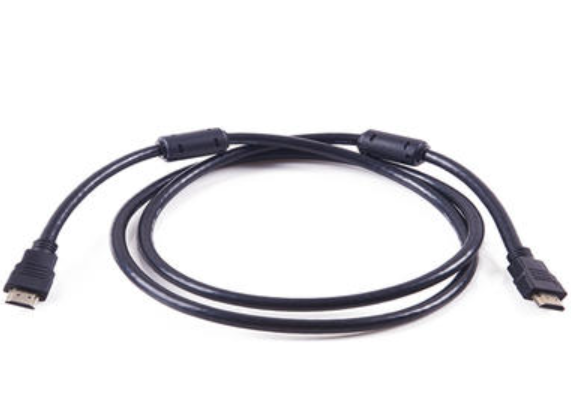
How Long Can an HDMI Cable Be?
HDMI (High-Definition Multimedia Interface) cables have become an essential component in connecting various audio and video devices. Whether you're setting up a home theater system or connecting your gaming console to a TV, understanding the basics of HDMI cables is crucial.
In this article, we will explore the key aspects of HDMI cables, including their purpose, length limitations, quality considerations, durability, and the differences between various HDMI cable options.
In this article, we will explore the key aspects of HDMI cables, including their purpose, length limitations, quality considerations, durability, and the differences between various HDMI cable options.
What Is an HDMI Cable?
HDMI cables serve as a means of transmitting high-quality audio and video signals between devices. They are designed to ensure a seamless connection and deliver digital data in a standardized format.
HDMI cables support high-definition resolutions and provide an all-in-one solution for transmitting both audio and video signals, making them popular in home entertainment systems, gaming setups, and other multimedia applications.
HDMI cables support high-definition resolutions and provide an all-in-one solution for transmitting both audio and video signals, making them popular in home entertainment systems, gaming setups, and other multimedia applications.
How Long Can an HDMI Cable Be?
The maximum length of an HDMI cable depends on various factors. Standard HDMI cables can typically transmit signals effectively over distances of up to 50 feet (15 meters).
Beyond this length, the signal quality may start to degrade due to attenuation. However, using signal boosters or HDMI extenders can overcome this limitation, allowing for longer cable runs, such as in commercial installations or larger home theater setups.
Beyond this length, the signal quality may start to degrade due to attenuation. However, using signal boosters or HDMI extenders can overcome this limitation, allowing for longer cable runs, such as in commercial installations or larger home theater setups.
Do HDMI Cables Matter?
The quality of HDMI cables can impact the overall performance and signal integrity, but it's important to understand that expensive cables are not always necessary for most consumer applications.
For shorter cable runs (up to 15 feet), basic HDMI cables labeled as "High-Speed" or "Category 2" are sufficient to transmit high-definition signals, including 4K resolution and audio formats like Dolby Atmos. Unless you have specific requirements for longer cable runs or specialized applications, investing in expensive HDMI cables might not offer significant benefits over more affordable options.
For shorter cable runs (up to 15 feet), basic HDMI cables labeled as "High-Speed" or "Category 2" are sufficient to transmit high-definition signals, including 4K resolution and audio formats like Dolby Atmos. Unless you have specific requirements for longer cable runs or specialized applications, investing in expensive HDMI cables might not offer significant benefits over more affordable options.
Do HDMI Cables Go Bad?
HDMI cables, like any other electronic component, can potentially fail over time. However, it is relatively rare for HDMI cables to go bad unless they are subjected to physical damage or excessive wear and tear.
If a cable is working properly, it is unlikely to degrade in performance or cause signal issues with regular use. It is always advisable to handle HDMI cables carefully, avoiding bending or stressing the connectors, as these can contribute to eventual failure.
If a cable is working properly, it is unlikely to degrade in performance or cause signal issues with regular use. It is always advisable to handle HDMI cables carefully, avoiding bending or stressing the connectors, as these can contribute to eventual failure.
Are All HDMI Cables the Same?
While all HDMI cables serve the same purpose of transmitting audio and video signals, there are different types and versions available. HDMI cables are classified based on their capabilities and features. For most consumer applications, High-Speed HDMI cables (Category 2) are sufficient and can support resolutions up to 4K.
However, there are also Premium High-Speed HDMI cables and Ultra High-Speed HDMI cables that offer additional features like support for higher refresh rates, wider color gamuts, and enhanced audio formats. It's essential to match the HDMI cable specifications with the requirements of your devices and the desired performance level.
However, there are also Premium High-Speed HDMI cables and Ultra High-Speed HDMI cables that offer additional features like support for higher refresh rates, wider color gamuts, and enhanced audio formats. It's essential to match the HDMI cable specifications with the requirements of your devices and the desired performance level.
Conclusion
HDMI cables play a crucial role in connecting audio and video devices, offering high-quality signal transmission and convenience.
Understanding the basics of HDMI cables, such as their purpose, length limitations, quality considerations, durability, and the different options available, can help you make informed choices when setting up your entertainment systems.
By considering the specific needs of your setup and opting for cables that meet those requirements, you can ensure optimal performance and an immersive multimedia experience.
Understanding the basics of HDMI cables, such as their purpose, length limitations, quality considerations, durability, and the different options available, can help you make informed choices when setting up your entertainment systems.
By considering the specific needs of your setup and opting for cables that meet those requirements, you can ensure optimal performance and an immersive multimedia experience.







Leave a comment